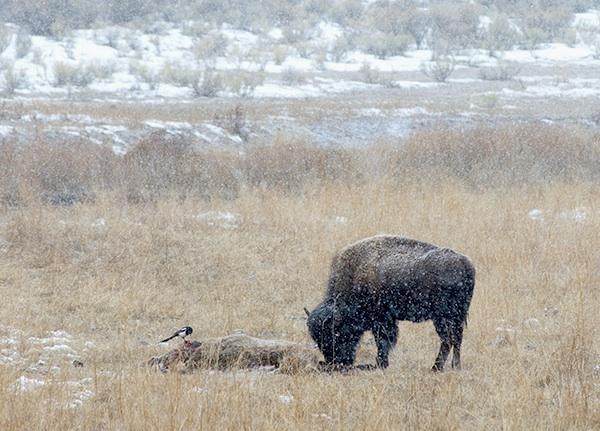
In an unusually poignant display, a bison seems to mourn an elk cow. Deby Dixon photo.
It is March madness in Yellowstone. The weather is warming, the snow is melting, the rivers rising. The bluebirds have come back to town, and every once in awhile one might see a splash of intense blue flitting across the otherwise drab landscape.
Some bison found some green grasses today, and one would think that they hit the bison lottery after a winter of dry and lifeless munchies that have left tracings of their backbones showing in their hides and their dispositions less than sunny.
With March comes a crust on the deep snow that allows the predators to run more easily while their prey sink and stumble, allowing jaws to bite into sensitive skin.
With spring and the renewal of the landscape comes death. Animals that did not survive the long, hard winter dot the landscape, their bodies thawing under the intense mid-day sun. Bears are awakening from their winter somber and the smell of the decaying carcasses call out to them. After only a few months' reprieve, the wolves are once again competing with the bears for their food.
Many animals are on the brink of death and most of those will die in the coming month. Photography of wildlife in our national parks is as much about the dead and dying as it is the living. One does not take the beauty of our wild creatures without the harsh realities of their struggle to survive.
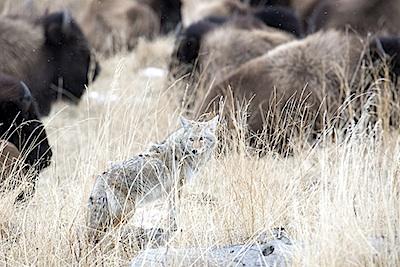
Coyotes maneuver carefully around bison. Deby Dixon photo.
Several years ago I was taking a photojournalism course and my instructor told me to quit photographing animals because it was people who told the stories. Well, as you saw from last month's column, some can make the stories of people come alive, while others can make the stories of creatures so vibrant that they sit and simmer on one's conscience, nibbling away at the senses and making others see wild animals as living, breathing and feeling beings. I am the latter and once my instructor instructed me to quit photographing wildlife, I set about proving that they are also stories, and just as important.
Bison Mourn a Cow Elk
While an animal carcass is death, it is more about life. At this very moment I am sitting in my car, next to the Gardner River, with one eye on a fresh deer carcass across the way. Some fur lies on the ground but so far the animal is intact, possibly taken down by a wolf that was scared off by the traffic. I sit here because before too long life will come to feed, in the form of ravens, magpies, eagles, coyotes and possibly a fox, bear or a wolf.
About six weeks ago, in a location very near where I am sitting now, there was a fresh elk carcass. Only, when I arrived, the dead animal was difficult to find. A few people sat in their vehicles, looking dully across the area where a few birds flew and some bison lingered. Finally, someone pointed in the direction of the elk and to one of the most baffling scenes I have seen amongst wildlife.
A young bull bison was nudging the dead animal with its nose, trying to get it back on its feet. The bison would sniff, gently nudge, lick and push with a hoof. Immediately I assumed that we were not looking for an elk after all, but a bison that had passed on. But, something did not look right and so I got my scope for a closer look and discovered that the young bull was trying to revive a cow elk. Now, this was a baffling story that could only be told with images; otherwise, who would believe me? My own eyes were telling me one thing while my brain told me that this could not be happening, bison are not fond of other species - they barely tolerate each other, but they do have funerals when one of their own passes on.
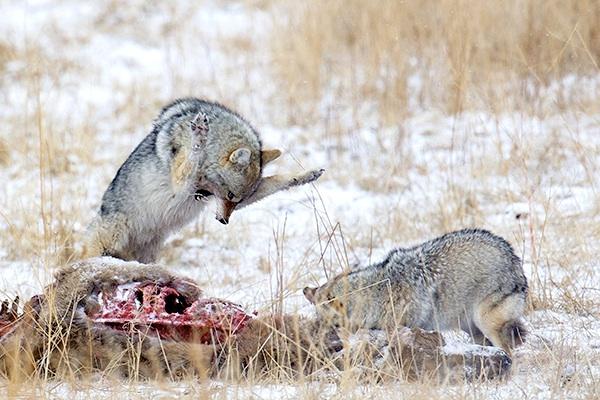
Battles erupt over a meal. Deby Dixon photo.
Every carcass has its own story but this was by far the most important one that I had ever witnessed - affection and mourning across two species.
I worked quickly to capture the different episodes of the bison mourning the cow elk because chances were that it was something that I would never see again. After some attempts to bring the elk to its feet, the bison laid down next to its friend, so close that his nose was practically touching her back, and he remained that way for some time. In fact, several bison rested close by.
While sitting there and watching, I wondered what the elk meant to the small herd of bison and how they had come to be friends. I wracked my memory for a vision of an elk traveling and eating with the bison but nothing came to me. Though, some time later, a person who read my story on Facebook wrote to say that they had seen a lone elk hanging with some bison in the same area and had thought it curious. I can only speculate but perhaps they had been friends.
After a time the bison rose to its feet, sniffed the elk and moved off just a short ways where he fed for awhile, never seeming to takes his eye off of his friend. The end of the day began to draw near and the bison began to wander off, except that each and every one of them stopped by the elk carcass to say goodbye. The young bull was the last and he stood there with his friend, long after his herd mates had moved on, saying his last goodbyes.
Even before the bison that had surrounded the elk had moved off, a gutsy coyote wove its way through and around the large beasts on its way over to the elk carcass. I have seen bison chase coyotes off of other bison carcasses, when they were preparing for their funerals, and so didn't know what to expect. The coyote was cautious however, as were the magpies, and they mostly seemed to just be waiting for the bison to move away before their feasting could begin.
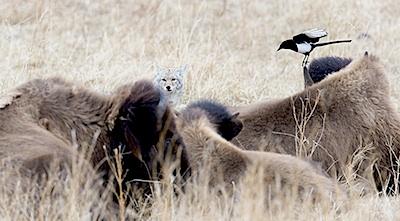
A segment of Yellowstone's wild kingdom. Deby Dixon photo.
This story took place on January 29 and the day was filled with snow, gray skies, and only spots of sunlight, now and then. Not great weather for photography but, as I have said many times, getting a great photo is second to watching and documenting the story of nature. The sun went down on the day and coyotes, eagles, magpies and ravens had come and gone. I went home, with plans to return early the next morning.
As dawn began to rise the following morning I could make out the shapes of a four-legged animal tearing at the carcass and so hoped that the light would soon shine on a wolf but it was only a coyote. It was clear that some larger animals had fed on the elk under the glint of stars that had most likely hidden behind clouds during the winter night. Naturally, and ultimately, my hope was to see a wolf, or wolves come in to feed but I knew that was unlikely, given how close the elk had landed to the road.
Photography of wildlife in parks can be challenging because all too often one might stand around for a very long time, waiting for action, and just as an interesting predator arrives at the carcass, so do the other photographers.
I am always amazed at how often a photographer will approach wildlife, getting way too close and scaring them off, ruining the photo ops for those of us who had been waiting for hours, and for themselves. I will often encourage people to stand back some, to give the animals room to come and go from the scene, only to be met with anger and determination to remain close. At which point I ask them, "Do you want to stand close to the carcass and not get any shots, or do you want to stand further back and get some shots?"
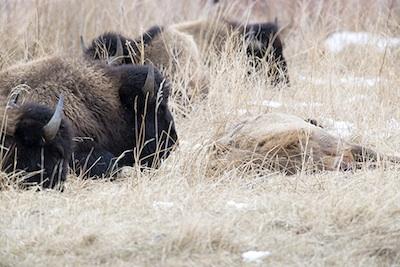
Life and death in Yellowstone. Deby Dixon photo.
Seems like an easy choice to me, but you would be surprised at how many photographers stubbornly remain close to the scene, spooking off all chances of getting any photographs. Once this happens is when I usually leave.
Just a few days before this cow elk was killed, and just a ways down the road, I had come across another carcass and a whole lot of action by four coyotes that were chasing each other around and doing some fighting. At the very least, I hoped that these four song dogs would arrive at this meal and repeat some of the posturing, snarling, and chasing that I had seen previously.
The four coyotes did arrive, one at a time, and one was quite skittish around people, but also so beautiful that photographers found it necessary to run down to the river bank for closer shots, scaring it off each time that the activity got good. Patience paid off and there did finally come a time when the animal's hunger and competitive spirit won out and we did get about five minutes of the coyotes chasing each other around. I must say that they are some of the most expressive animals that I have ever photographed.
All told, I probably spent about 10 hours at the elk carcass, documenting each new scene as it occurred. The herd of bison never moved far way and they were a constant reminder of the sorrow I had witnessed during the my first moments on the scene. What had amazed me back in the beginning, when the bison bull was trying to get the elk back on its feet, was the passive way some photographers sat and watched, waiting and hoping for a wolf. I always hope for a wolf also, but have learned to embrace each episode of life at a carcass as a magical moment that teaches me more about our natural world.
It is now snowing heavily and the deer carcass has nearly disappeared in the darkness of the heavy snow. By tomorrow morning she will be a rack of bones with birds pecking away for any morsels that were left behind. Animals die and many more get to live.



Comments
Debbie, that is a wonderful, interesting story. Thanks for sharing and for your photos.
Great story and pictures. Please never listen to that guy who told you not to photograph animals.